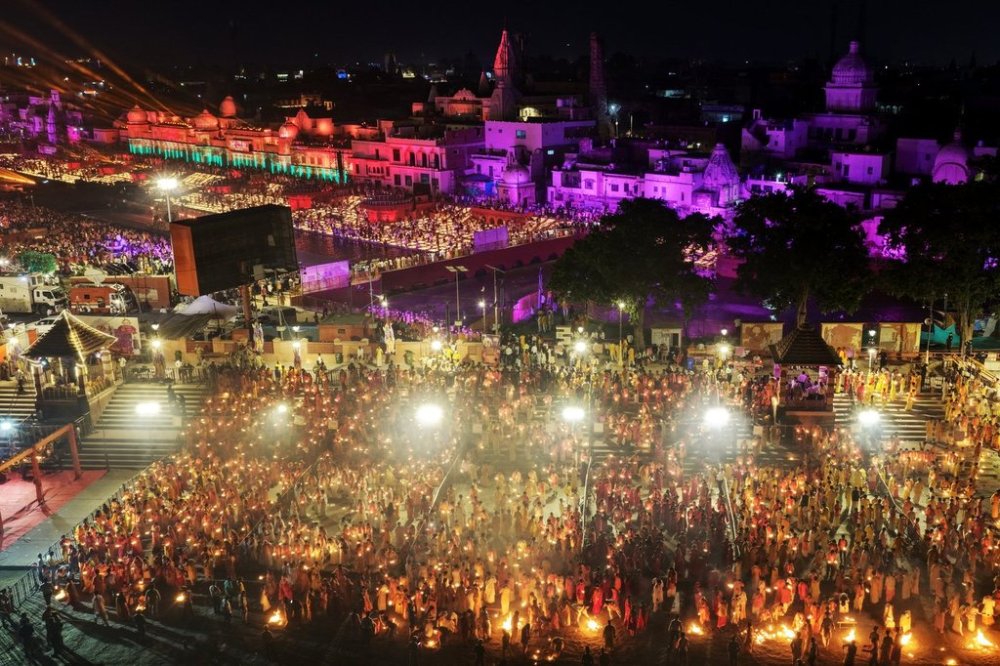Millions of Indians celebrate Diwali, the Hindu festival of lights
Advertisement
Read this article for free:
or
Already have an account? Log in here »
To continue reading, please subscribe:
Monthly Digital Subscription
$0 for the first 4 weeks*
- Enjoy unlimited reading on winnipegfreepress.com
- Read the E-Edition, our digital replica newspaper
- Access News Break, our award-winning app
- Play interactive puzzles
*No charge for 4 weeks then price increases to the regular rate of $19.00 plus GST every four weeks. Offer available to new and qualified returning subscribers only. Cancel any time.
Monthly Digital Subscription
$4.75/week*
- Enjoy unlimited reading on winnipegfreepress.com
- Read the E-Edition, our digital replica newspaper
- Access News Break, our award-winning app
- Play interactive puzzles
*Billed as $19 plus GST every four weeks. Cancel any time.
To continue reading, please subscribe:
Add Free Press access to your Brandon Sun subscription for only an additional
$1 for the first 4 weeks*
*Your next subscription payment will increase by $1.00 and you will be charged $16.99 plus GST for four weeks. After four weeks, your payment will increase to $23.99 plus GST every four weeks.
Read unlimited articles for free today:
or
Already have an account? Log in here »
NEW DELHI (AP) — Millions of Indians celebrated Diwali on Monday as lamps illuminated homes and streets across the country to mark the Hindu festival symbolizing the victory of light over darkness.
Diwali, derived from the word “Deepavali,” meaning “a row of lights,” is typically celebrated by socializing and exchanging gifts. The dates of the festival are based on the Hindu lunar calendar, typically falling in late October or early November.
Shoppers crowded markets to buy flowers, lanterns and candles.

The celebrations were most visible in Ayodhya city in Uttar Pradesh state. Hindus believe the deity Lord Ram was born there and returned after 14 years in exile. People light earthen lamps to mark his homecoming.
As dusk fell Sunday, more than 2.6 million lamps were lit on the banks of the Saryu River in Ayodhya, retaining the Guinness World Record set last year. At least 2,100 Hindu priests performed prayers in unison, their chants echoing across the shimmering riverfront.
The holy city was also decked with fairy lights, and a laser and fireworks show illuminated its lanes and riverbanks. Thousands of residents lit lamps at houses and temples.
Officials said more than 33,000 volunteers helped light the lamps. Nearly 40 families from nearby villages produced 1.6 million lamps. At least 73,000 liters of oil and 5.5 million cotton wicks were used to light the city.
“It is hard work lighting diyas (oil lamps) one by one,” said 19-year-old volunteer Rachit Singh, his face glowing in the firelight. “But when you see the whole ghat (stairs to the river) light up, every bit of effort feels worth it.”
In recent years, Diwali celebrations in New Delhi have been clouded by concerns over air pollution, as smoke-emitting firecrackers cause toxic smog that can take days to clear.
On Monday, the level of tiniest particulates surged to 347 on the air quality index in parts of the city — about 14 times the World Health Organization’s daily recommended maximum exposure — according to SAFAR, the federal government’s air quality monitoring agency.

Last week, India’s top court eased a blanket ban on firecrackers in New Delhi during Diwali, allowing limited use of “green firecrackers” that emit fewer pollutants. Developed by federal research institutes, they are designed to cut particulate and gas emissions by about 30%.
The court said they could be used during specific hours from Saturday to Tuesday.
___
Associated Press writer Biswajeet Banerjee in Lucknow, India, contributed to this report.

